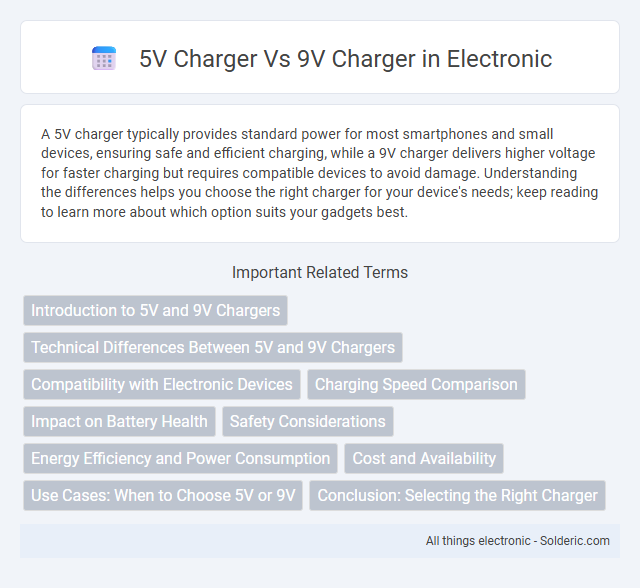A 5V charger typically provides standard power for most smartphones and small devices, ensuring safe and efficient charging, while a 9V charger delivers higher voltage for faster charging but requires compatible devices to avoid damage. Understanding the differences helps you choose the right charger for your device's needs; keep reading to learn more about which option suits your gadgets best.
Comparison Table
| Feature | 5V Charger | 9V Charger |
|---|---|---|
| Voltage Output | 5 Volts | 9 Volts |
| Charging Speed | Standard, slower charging | Faster charging, suitable for quick charge |
| Power Delivery | Lower wattage, typically up to 12.5W | Higher wattage, can go up to 18W or more |
| Device Compatibility | Common for smartphones, basic devices | Ideal for fast-charge compatible devices |
| Heat Generation | Less heat produced | More heat due to higher power |
| Use Case | Everyday charging | Fast charging when time is limited |
Introduction to 5V and 9V Chargers
5V chargers typically provide standard charging power suitable for most smartphones and small electronic devices, delivering a steady 5 volts to ensure safe and efficient battery replenishment. In contrast, 9V chargers offer higher voltage output, often used in fast charging technologies like Qualcomm Quick Charge or USB Power Delivery, enabling quicker energy transfer and reduced charging time for compatible devices. Selecting between 5V and 9V chargers depends on device specifications and charging speed requirements, ensuring optimal performance and battery health.
Technical Differences Between 5V and 9V Chargers
5V chargers typically provide a standard voltage suited for most smartphones and small electronic devices, supporting current outputs around 1-2A for efficient charging. In contrast, 9V chargers deliver higher voltage designed for fast-charging compatible devices by increasing power output while managing thermal dissipation through advanced circuitry. The technical difference lies in voltage regulation and power profiles, where 9V chargers often include dynamic voltage scaling and safety features to prevent overheating and ensure device compatibility.
Compatibility with Electronic Devices
A 5V charger is widely compatible with most smartphones, tablets, and small electronic gadgets, making it the standard voltage for USB charging. In contrast, a 9V charger is typically used for devices requiring faster charging or higher power, such as certain smartphones with Quick Charge technology or specific electronic accessories. Your choice between a 5V and 9V charger should depend on the voltage requirements specified by your device to ensure safe and efficient charging.
Charging Speed Comparison
A 9V charger typically provides faster charging speeds compared to a 5V charger due to its higher voltage output, enabling quicker energy transfer to compatible devices. Devices designed to support fast charging protocols, such as Qualcomm Quick Charge, often utilize 9V chargers to reduce overall charging time significantly. However, charging speed also depends on the device's battery capacity and internal power management system, making 9V chargers more efficient for rapid charging when matched with suitable hardware.
Impact on Battery Health
A 5V charger typically delivers a lower voltage that generates less heat during charging, preserving battery longevity and reducing the risk of capacity degradation. In contrast, a 9V charger provides higher voltage output, which can accelerate charging speed but may increase thermal stress and cause faster wear on battery cells over time. Optimal battery health depends on balancing charging speed with heat management, making 5V chargers generally safer for prolonged battery life.
Safety Considerations
A 5V charger typically offers safer charging for most everyday devices due to its lower voltage output, reducing the risk of overheating or damaging your battery. In contrast, a 9V charger provides faster charging but requires compatible devices designed to handle higher voltage safely to prevent potential hazards like short circuits or battery swelling. Ensuring your device specifications match the charger voltage is crucial for maintaining optimal safety during use.
Energy Efficiency and Power Consumption
A 5V charger typically offers higher energy efficiency with lower power consumption, making it ideal for everyday devices requiring steady, moderate power. In contrast, a 9V charger delivers higher voltage, which can increase power consumption but speeds up charging for compatible devices with fast-charging technology. Your choice between 5V and 9V chargers should balance the efficiency needs and the specific power demands of your devices.
Cost and Availability
5V chargers are generally more affordable and widely available due to their compatibility with most smartphones, tablets, and USB-powered devices. 9V chargers, often used for fast charging and specific devices, tend to be pricier and less common in general retail stores. The cost difference reflects the specialized technology in 9V chargers, which also limits their availability compared to the ubiquitous 5V options.
Use Cases: When to Choose 5V or 9V
A 5V charger is ideal for everyday devices like smartphones, tablets, and small wearables, providing a standard charging voltage compatible with most USB-powered gadgets. A 9V charger suits fast-charging protocols for compatible devices such as newer smartphones and tablets, delivering higher voltage to reduce charging time significantly. Choosing between 5V and 9V chargers depends on the device's power requirements and compatibility with fast charging standards like Qualcomm Quick Charge or USB Power Delivery.
Conclusion: Selecting the Right Charger
Choosing between a 5V charger and a 9V charger depends on the device's power requirements and charging speed preferences. A 5V charger is suitable for most smartphones and small gadgets, offering safe and steady charging, while a 9V charger provides faster charging for devices supporting Quick Charge or similar technologies, reducing downtime significantly. Ensuring compatibility with your device's voltage specifications maximizes efficiency and prevents battery damage.
5V charger vs 9V charger Infographic

 solderic.com
solderic.com